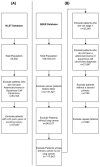Sex-Based Differences in Lung Cancer Incidence: A Retrospective Analysis of Two Large US-Based Cancer Databases
- PMID: 39409866
- PMCID: PMC11476236
- DOI: 10.3390/cancers16193244
Sex-Based Differences in Lung Cancer Incidence: A Retrospective Analysis of Two Large US-Based Cancer Databases
Abstract
Background/Objectives: Non-small cell lung cancer (NSCLC) has seen a relative rise in incidence among females versus males in recent years, although males still have a higher overall incidence. However, it is unclear whether this trend is consistent across all populations. Therefore, we retrospectively examined this relationship in two large high-risk clinical cohorts. Methods: First, we analyzed lung cancer incidence among individuals with a smoking history of over 40 pack-years in the National Lung Screening Trial (NLST). Then, we investigated the incidence of second primary NSCLC in patients who underwent lobectomy for previous stage I lung cancer using the Surveillance, Epidemiology, and End Results (SEER) database. We performed both univariate and multivariable time-to-event analyses to investigate the relationship between sex and lung cancer incidence. Results: In the NLST cohort (n = 37,627), females had a higher risk of developing primary NSCLC than males (HR = 1.11 [1.007-1.222], p = 0.035) after adjusting for age and pack-year history. In the SEER cohort (n = 19,327), females again exhibited an increased risk of developing a second primary lung cancer (HR = 1.138 [1.02-1.269], p = 0.021), after adjusting for age, race, grade, and histology. Conclusions: Our analysis reveals that females have a modestly higher lung cancer incidence than males in high-risk populations. These findings underscore the importance of further researching the underlying cellular processes that may cause sex-specific differences in lung cancer incidence.
Keywords: NLST; NSCLC; SEER; lung cancer incidence; sex disparities.
Conflict of interest statement
The authors report no proprietary or commercial interest in any product mentioned or concept discussed in this article. The funding sponsors had no role in the choice of research project; design of the study; in the collection, analyses, or interpretation of data; in the writing of the manuscript; or in the decision to publish the results.
Figures


Similar articles
-
Estimation of the tumor size at cure threshold among aggressive non-small cell lung cancers (NSCLCs): evidence from the surveillance, epidemiology, and end results (SEER) program and the national lung screening trial (NLST).Int J Cancer. 2017 Mar 15;140(6):1280-1292. doi: 10.1002/ijc.30548. Int J Cancer. 2017. PMID: 27925181
-
Gender and lung cancer-SEER-based analysis.Ann Epidemiol. 2020 Jun;46:14-19. doi: 10.1016/j.annepidem.2020.04.003. Epub 2020 May 7. Ann Epidemiol. 2020. PMID: 32532368
-
Assessing the Generalizability of the National Lung Screening Trial: Comparison of Patients with Stage 1 Disease.Am J Respir Crit Care Med. 2017 Sep 1;196(5):602-608. doi: 10.1164/rccm.201705-0914OC. Am J Respir Crit Care Med. 2017. PMID: 28722466 Free PMC article.
-
20-Year Comparative Survival and Mortality of Cancer of the Stomach by Age, Sex, Race, Stage, Grade, Cohort Entry Time-Period, Disease Duration & Selected ICD-O-3 Oncologic Phenotypes: A Systematic Review of 157,258 Cases for Diagnosis Years 1973-2014: (SEER*Stat 8.3.4).J Insur Med. 2019;48(1):5-23. doi: 10.17849/insm-48-1-1-19.1. Epub 2019 Oct 14. J Insur Med. 2019. PMID: 31609640
-
Non-Hodgkin Lymphoma - Nodal and Extranodal: 20-Year Comparative Mortality, Survival & Biologic Behavior Analysis by Age, Sex, Race, Stage, Cell Morphology/Histology, Cohort Entry Time-Period and Disease Duration: A Systematic Review of 384,651 Total NHL Cases Including 261,144 Nodal and 123,507 Extranodal Cases for Diagnosis Years 1975-2016: (SEER*Stat 8.3.6).J Insur Med. 2023 Jul 1;50(1):1-35. doi: 10.17849/insm-50-1-1-35.1. J Insur Med. 2023. PMID: 37725503
References
Grants and funding
LinkOut - more resources
Full Text Sources

